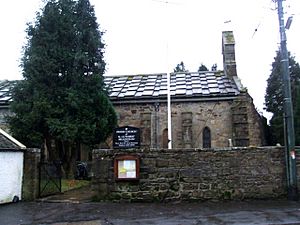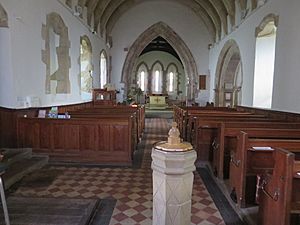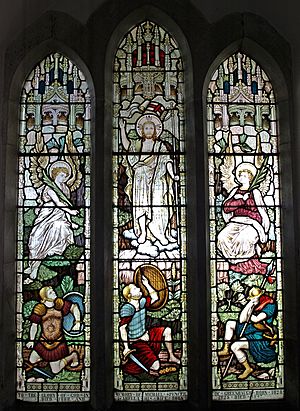Church of St Cuthbert, Bellingham facts for kids
Quick facts for kids Church of St Cuthbert |
|
|---|---|

View of church from the north showing the western end of the nave and its unusual stone slab roof.
|
|
| Location | Bellingham, Northumberland |
| Built | 13th century |
| Built for | Catholic Church in England and Wales |
| Rebuilt | 1609 |
| Governing body | Church of England |
|
Listed Building – Grade I
|
|
| Official name: Church of St Cuthbert | |
| Designated | 10 November 1951 |
| Reference no. | 1370442 |
The Church of St Cuthbert is a very old and important church in Bellingham, Northumberland. It's owned by the Church of England. Some parts of the church are from the 1200s! It even survived attacks from groups called border reivers who burned down many other buildings in the village long ago. The church has a main area called the nave, a special area for the altar called the chancel, and a big side room called a chapel. Its roof is quite special, especially over the chancel, because it's made of flat stone pieces called slate. Outside, in the churchyard, you can find a tomb called the "Lang Pack." It's part of a cool local legend about a robbery!
About the Church
History and Location
The Church of St Cuthbert is found at the west end of Bellingham High Street. It's a bit hidden behind the Black Bull Hotel. Parts of this church were built in the 1200s. It was lucky to survive the time of the border reivers. These groups often raided and burned down many other old buildings in the village.
During some building work in 1861, three old cannonballs were found inside the roof! These probably came from an attack in 1597. That's when Bellingham was attacked by a leader named Walter Scott.
Right next to the church is St Cuthbert's Well. People say that Saint Cuthbert discovered this well in the 600s. The water from the well was believed to have healing powers. The church even used this special water for baptisms. Because of its age and importance, the church was given special protection on November 10, 1951. It is now a Grade I listed building. This means it's considered a very important historical site.
How the Church is Built
The church was rebuilt a lot in 1609 and fixed up again in 1865. That's when a small tower for bells, called a bellcote, was added at the west end. The church has three main parts: the nave (the main area where people sit), the chancel (the area near the altar), and a large south chapel (a side room).
The nave has six sections, called bays. Between these sections are tall, narrow windows called lancet windows. These windows probably date back to the 1600s. On the north side, there's a shallow arched doorway with a door from the 1600s. A copper lamp from the 1800s hangs above it. There was a similar doorway on the south side, but it has been closed up.
At the west end of the nave, two large stone supports, called buttresses, were added in the 1800s. A lancet window was put between them. Most of the other buttresses on the church are from the 1600s. The nave has a special roof shaped like a half-barrel, called a barrel vault. It's made of stone slabs and supported by 15 ribs. This roof is very unusual because it's made of alternating thick and thin strips of stone from Lakeland slate.
The chancel part of the church is from the 1200s. It has an original window on its south wall. There are also three newer lancet windows at the east end. The chancel has an arch from the 1200s with a special double-edged design. On the north wall, you can see memorials to people like Archibald Reed (from 1729) and Theresa and Harriet Charlton (from 1829). A memorial to Charlton of Redesmouth (from 1628) stands outside the south wall.
The south chapel is very big. You can enter it from the nave through a rounded arch that was built in 1609. This chapel has a window from the 1200s and a square window from the 1600s. It also has a barrel vault roof made of stone slabs, just like the nave.
The Lang Pack Legend
In the churchyard, just a few steps from the church entrance, there's a very interesting tombstone known as the "Lang Pack." This tomb is connected to a famous local legend about a robbery at a nearby house called Lee Hall.
The story goes that in the winter of 1723, the owner of Lee Hall, Colonel Ridley, went to London. He left the hall with only three servants and told them not to let anyone in. One night, a pedlar came to the hall, looking for a place to stay. The servants wouldn't let him in, but they did allow him to leave his very large pack inside the hall.
Later that night, the servants saw the pack move! One of them shot it with a pistol. When they opened the bag, they found a man's body inside. He had a whistle around his neck. The servants figured out that he was planning to rob the hall. He would have blown the whistle to tell his gang to come once the door was open. So, the servants armed themselves, blew the whistle, and scared off the gang when they arrived.
People say that the tomb at the church holds the body of the man found in that "Lang Pack." There's even a sign in the churchyard that names it. This legend might be based on real events, as house robberies were common back then. A local poet from Bellingham, Robert Allen, even wrote a poem about this story in the local Geordie dialect.



